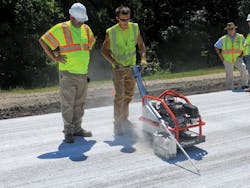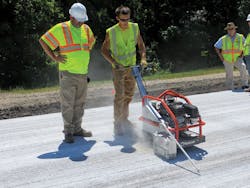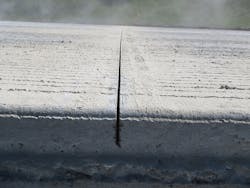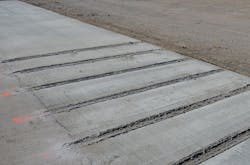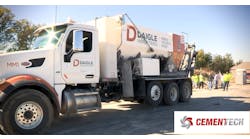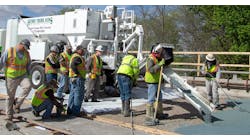By: James A. Crovetti, Ph.D., John T. Kevern, Ph.D., P.E., Myungook Kang, Ph.D., and Kevin McMullen, P.E.
Joint deterioration has become a renewed concern for concrete pavements in northern climates.
Recently, a number of relatively young pavements have experienced premature joint deterioration, resulting in high amounts of maintenance. The construction industry in Wisconsin alone estimates approximately $60 million in yearly expenditures for concrete pavement repairs, of which about $15-30 million is targeted to repair concrete joints due to durability issues. Generally, older pavements were found less susceptible to joint damage, even in areas with high concentrations of deicing agents used during winter maintenance operations, prompting recent investigations focusing on changes in construction and maintenance techniques.
In the fall of 2015, the Wisconsin Department of Transportation (WisDOT) initiated a study to investigate the effects of joint sawing practices on concrete joint durability. The study, completed by researchers at Marquette University and the University of Missouri–Kansas City, included the construction of two concrete pavement test sections and the review of a number of in-service pavements with and without joint distress. This article discusses the results obtained from the concrete pavement test sections designed and constructed to allow for the creation of a wide range of saw-cut joints, including provisions for saw type, saw blade type and quality, depth of saw cut, and saw cut timing.
Going both ways
WisDOT currently allows the use of both conventional wet sawing and early-entry dry cut sawing for the formation of transverse contraction joints. While the specific type of sawing technique is usually left to the contractor’s discretion, the depth of sawing is routinely specified at one-third of the slab thickness (D/3). The timing of joint sawing operations also is critical, and WisDOT specifies that sawing should begin as soon as the concrete hardens sufficiently to prevent excessive raveling along the saw cut and finish before conditions induce uncontrolled cracking.
In the fall of 2015, WisDOT initiated a study, completed by researchers at Marquette University and the University of Missouri-Kansas City, to investigate the effects of joint sawing practices on concrete joint durability. The study included construction of two concrete pavement test sections and the review of a number of in-service pavements with and without joint distress.
Testing it out
The initial concrete test section constructed in October 2015 was designed to allow for the installation of numerous D/3 saw cut joints using variations in saw type, saw blade type, saw cut timing and concrete mixture type. This section was constructed on the grounds of the Zignego Ready-Mix Plant in Waukesha, Wis., which eliminated the need for traffic-control provisions during the paving operations and subsequent sawing/sampling operations. This section included two distinct hand-pour mixture designs, one incorporating a softer southern Wisconsin limestone as the predominant coarse aggregate and the other a harder northern Wisconsin igneous gravel.
Each mixture was utilized to construct a continuous concrete slab that was 10 in. thick, 10 ft wide and 50 ft long. The mixtures were placed adjacent to each other, resulting in a total paved length of 100 ft. Each mixture utilized an optimal aggregate gradation, a design water to cementitious materials (w/cm) ratio of 0.42, a design air content of 6%, and slump values targeted between 2-4 in.
The overall saw cutting research factorial included the primary factor of mix design type (limestone or gravel coarse aggregate) and four additional factors as follows:
- Factor 1: Saw Type—Early Entry or Conventional;
- Factor 2: Saw Timing—Early, Optimal or Late in Allowable Window;
- Factor 3: Blade Type—Hard or Soft Aggregate; and
- Factor 4: Blade Wear—New or Aged.
Transverse saw cuts were made at longitudinal spacings of 2-3 ft, with adjacent cuts timed appropriately to mitigate temperature effects. For the early entry cuts, the aged blade condition was simulated by using a worn shoe plate with a widened saw blade portal.
The second concrete pavement test section was constructed in July 2017 as part of a highway improvement project and included a doweled, jointed plain concrete pavement (JPCP) placed over a reclaimed asphalt base layer. This section, constructed as a replacement for one of the on-ramps, included an 8-in.-thick pavement with a 15-ft paved width. A 900-ft-long portion of the ramp, incorporating 60 consecutive transverse joints, was established as a research section to allow for variations in saw cut depth and post-cut sealing operations.
The mix design was suitable for slipform paving and utilized an optimal aggregate gradation, a design w/cm ratio of 0.37 and had target air content and slump readings of 6% and 1.5 in., respectively. The coarse aggregate included both limestone and gravel constituents.
The section was designed to allow for the installation of numerous partial-depth saw cut joints, using a variation in early-entry saw type and saw cut depth. Saw cuts were made using depths of 2.67 in. (D/3), 2 in. (D/4) and 1.25 +/- 0.25 in. The full 900-ft test section was divided into three, 300-ft subsections, each comprised of 20 consecutive transverse joints cut to one of the selected saw depths. Within each of the three subsections, 10 joints were left unsealed, and the remaining 10 joints were sealed with field-applied silane-penetrating joint sealer.
All early-entry saw cuts were produced with portable saws operated by paving contractor crew members. For the cuts targeted for a depth of 1.25 in., a lightweight saw was used. The cuts that were to be sealed with field-applied silane-penetrating sealer were pressure-washed three days after paving. The silane-penetrating sealer was applied the day following washing, using equipment, materials and personnel provided by a local contractor.
In the lab
Representative samples were taken from each constructed joint to provide sufficient materials for comparative analyses. For the initial test section, four block samples measuring 12 in. wide (along the joint face) by 24 in. long (perpendicular to the joint) were obtained from each joint by full-depth sawing operations completed one month after paving. For the second test section, 6-in.-diam. full-depth cores were obtained from six randomly selected joints (three sealed and three unsealed) and one center slab location within each subsection one week after paving. All field samples were transported to the lab for documentation and performance testing.
Absorption was measured according to ASTM C1585 with the sawn face left exposed and all other faces sealed with 2-mil aluminum foil tape. Freeze-thaw durability was tested according to ASTM C666A. Relative dynamic modulus and mass were measured every 30 cycles according to ASTM C215. After it became apparent that the freeze-thaw durability of the field-sawn concrete was excellent and unable to differentiate between any sawing permutations, a modified freeze-thaw test was employed to better differentiate performance. Testing was performed using standard ASTM C666A equipment and cycle timing, except deicing fluid was introduced through one-dimensional capillary absorption from the bottom. Relative dynamic modulus and weight testing were measured every 30 cycles up to 300 cycles. Deicer scaling was tested using a version of ASTM C672 adapted to the specifics of testing joint performance. For each permutation, one sample was tested in the as-received condition and one coated with 40% silane. Silane-coated samples were allowed to dry a minimum of 24 hours before submersing in the deicer solution. Since this research was intended to investigate the influence sawing had on the physical properties, a 3% NaCl solution was used instead of CaCl2 to prevent additional joint damage caused by calcium oxychloride formation.
One of the concrete pavement test sections was designed to allow for the installation of numerous partial-depth saw cut joints, using a variation in early-entry saw type and saw cut depth. The full 900-ft test section was divided into three, 300-ft subsections, each comprised of 20 consecutive transverse joints cut to one of the selected saw depths. Within each of the three subsections, 10 joints were left unsealed, and the remaining 10 joints were sealed with field-applied silane-penetrating joint sealer.
Looking at samples
Limestone mixture samples from the initial test section, sawn very early in the sawing window with the early-entry equipment, all possessed marks where the shoe plate completely removed any tining and where the wheel compressed the surface. The surface condition of the early-entry joints improved with progression in the timing window. For the limestone mixture, the aggregate did appear disturbed and pulled towards the surface where the aggregate fractured against the shoe. The disturbance for the limestone mixture occurred directly beneath the sawing shoe. Early age damage also was observed for the gravel mixture where movement of the coarse aggregate caused a crack directly adjacent to the shoe.
Absorption testing indicated typical behavior in that water initially absorbed very quickly and then entered at a much slower absorption rate (one to 15 days). One-dimensional absorption was able to distinguish between the equipment conditions, with samples sawn with new blades producing much lower and less-variable absorption than samples sawn with the old blade.
All tested samples showed good freeze-thaw durability through 300 cycles. Testing performed to 600 cycles showed deterioration grouped into aggregate pop-outs and paste deterioration/erosion. Generally, the mass loss from the limestone specimens was related to aggregate pop-outs while mass loss from the gravel specimens was limited to deterioration of the paste. No specimens failed either mass or relative dynamic modulus criteria at either 300 or 600 cycles.
Deicer scaling and chloride penetration results for the limestone mixture indicated that silane treatment significantly improved deicer performance, with most coated samples having no visual difference after testing, and that penetration from the surface decreased from 0.50 in. (untreated) to 0.38 in. (treated). The deicer results for the gravel mixture had better performance than the limestone mixture, with performance improvement for both the untreated and silane-treated samples. The average penetration along the joint face reduced from 0.50 in. (untreated) to 0.26 in. (treated).
The core samples from the second test section indicated that the joint on all samples had activated, with the full-depth crack initiating near the saw tip and advancing around a majority of the adjacent coarse aggregate pieces. Generally, the tortuosity of the activated crack decreased as the saw depth increased. Absorption tests indicated a marked reduction in the initial absorption rates for all cores sealed in the field and in the lab. However, little effect was observed for the secondary absorption rates for all specimens. Modified freeze-thaw durability testing results indicated the total mass loss trended higher with testing age, which was expected as microcracks provided more space to retain the deicer solution before material flakes. Although significant erosion was observed at the sawn joint, the amount of mass lost was not enough to be observed for the majority of joints sample. However, cores obtained from one sealed joint within the 1.5-in. and D/3 sections had much lower dynamic modulus performance than any of the samples. After freeze-thaw testing in the deicer solution, a visual rating was performed on the sawn faces using the same criteria as ASTM C672 scaling. Performance using the visual criteria was directly related to the depth of sawing, with the deepest saw cuts having the best performance. In all cases, the silane-treated samples had worse performance than the untreated samples. It appeared that the paste containing the silane treatment eroded, leaving several millimeters of exposed aggregate.
What it all means
Sawing very early in the timing window using early-entry equipment did cause physical damage to the aggregate and concrete within the first test section. For the limestone aggregate, the damage occurred directly underneath the sawing shoe, while for the gravel aggregate a crack formed immediately outside and parallel to the shoe. Absorption results did not indicate greater potential for durability distress; however, freeze-thaw durability for early age limestone samples indicated that damage was detrimental to performance. No difference in freeze-thaw performance was observed for the gravel permutations.
Differences in absorption caused by sawing timing, technique and equipment were observed on samples obtained from the first test section. The gravel mixture had less absorption than the limestone mixture. Sawing early in the timing window produced the lowest absorption only if sawn using a new blade appropriate for the aggregate. An old/worn blade produces higher absorption and more variability in all cases than the corresponding joint sawn at the same time with a new blade. If the limestone aggregate mixture was sawn late in the timing window, a blade designed for harder aggregates produced less absorption. Silane treatment of the joints provided significant reduction in absorption and was able to minimize absorption from the worst sawing conditions.
Both concrete mixtures within the first test section were freeze-thaw durable to 300 cycles with no sawing permutations showing significant freeze-thaw deterioration at 300 cycles. Samples with significantly high or low absorption were tested until 600 cycles, and all but one sample had acceptable performance, indicating that the concrete was of high quality, considered highly freeze-thaw durable and not able to distinguish effects from sawing.
As expected, surface deicer scaling was not influenced by sawing factors. The limestone mixture had worse performance than the gravel mixture, with both significantly improved with the application of a topical silane sealer. Chloride penetration was not reduced for the limestone mixture by the application of silane, most likely due to the difficulty identifying a clear demarcation with the limestone aggregate. Chloride penetration was reduced 50% in the gravel mixture by the application of silane.
Silane application generally reduced absorption within the second test section; however, the variability was much greater than for the lab-coated specimens from the first test section, likely due to the already low absorption rate of the concrete.
Freeze-thaw durability of the cores from the second test section was excellent when evaluated using mass or relative dynamic modulus. However, at 300 cycles there was significant visual deterioration. Freeze-thaw performance was best for the deeper cuts sawn later in the window.
The researchers made the following recommendations for changes to current WisDOT specification and guidance documents:
- The contractor should provide a schedule for all blades used, showing cumulative length of sawing and depth of sawing, in addition to verification of appropriate blade selection for the predominant coarse aggregate contained in the concrete mixture. For early-entry saws, the alignment shoes must be replaced at the same intervals as the blades;
- Early-entry sawing equipment should only be allowable on mixtures containing predominantly igneous gravel coarse aggregates. Ensure that saws have diamond blades with functioning blade guards and are equipped to control cut alignment and depth. Sawing very early in the sawing window should be discouraged. The minimum time to commence sawing should not result in any marring of the surface texture;
- Worn blades cause measurable impact to concrete and a blade log with depth, distance, and time should be maintained by the contractor; and
- The use of silane produced an improvement in deicer scaling from the initial test section specimens but worse performance for the freeze-thaw samples from the second test section. Additional work is recommended before determining the effectiveness of silane in the field.
This article presents research findings from a study funded by the Wisconsin Department of Transportation (WisDOT) and the U.S. DOT in the interest of information exchange. The information reported is the result of research done under the auspices of WisDOT. The content of this publication reflects the views of the authors, who are responsible for the correct use of brand names, and for the accuracy, analysis and any inferences drawn from the information or material published. WisDOT and FHWA (U.S. DOT) assume no liability for its contents or use thereof. This publication does not endorse or approve any commercial product, even though trade names may be cited, and does not reflect official views or policies of the WisDOT or FHWA (U.S. DOT), and does not constitute a standard specification or regulation of the WisDOT or FHWA.
---------------
About the author:
Crovetti is an associate professor emeritus at Marquette University. Kevern is an associate professor and chair at the University of Missouri-Kansas City. Kang is a pavement policy and design engineer at WisDOT-BTS. McMullen is president of the Wisconsin Concrete Pavement Association.
